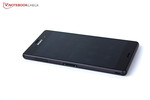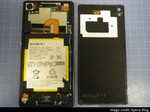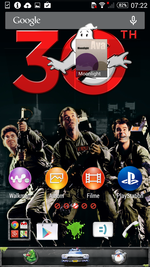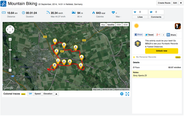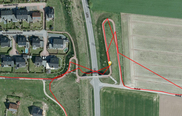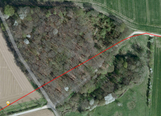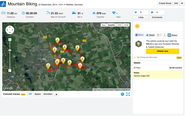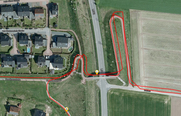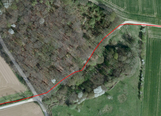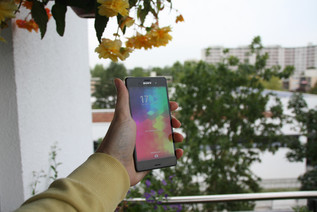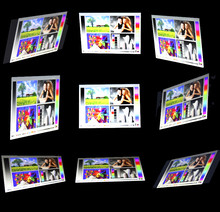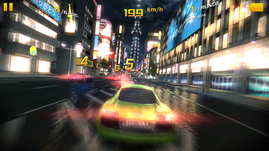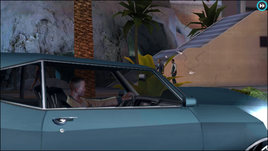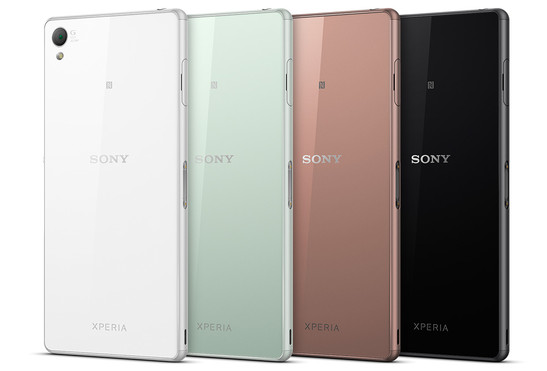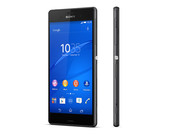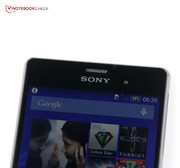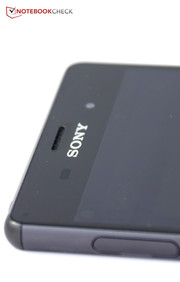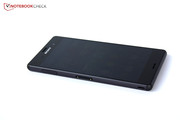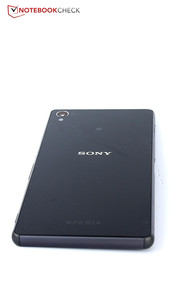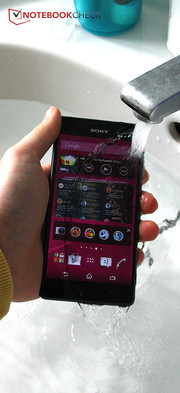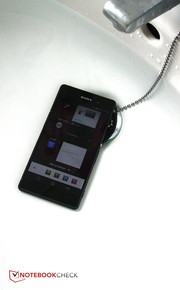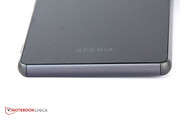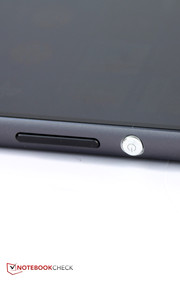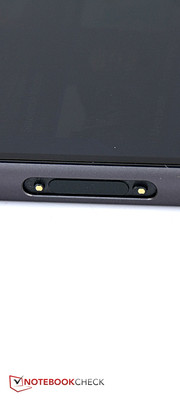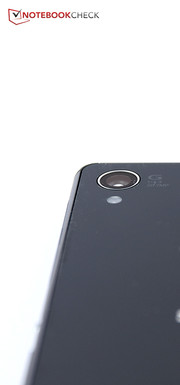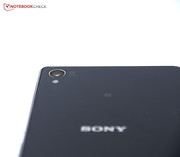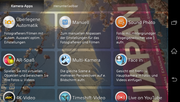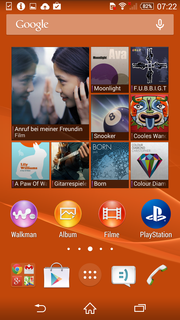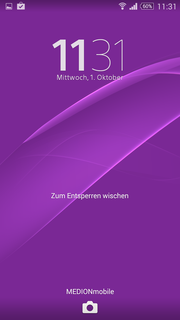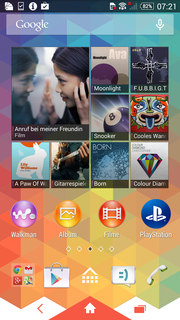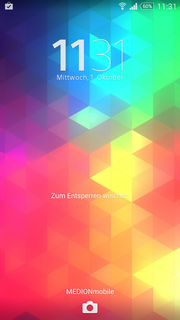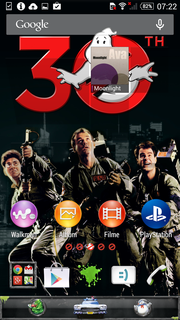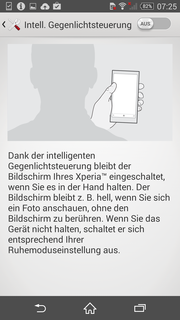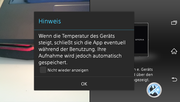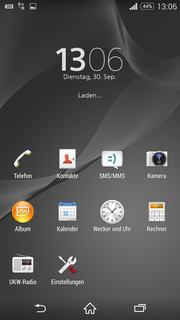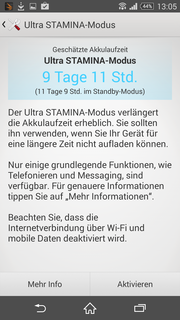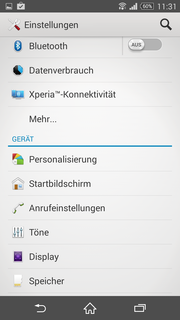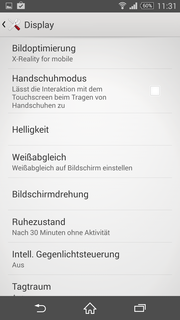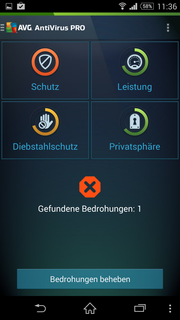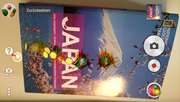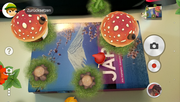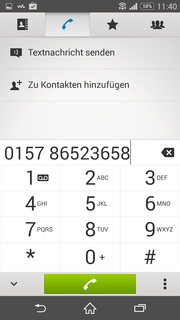Sony Xperia Z3 Smartphone Review

For the original German review, see here.
Not even five months have passed since we reviewed the Sony Xperia Z2. Now, the successor is already waiting in the wings. Certainly, it is also completely water and dust resistant and even faster - but is it also even better? It almost looks like Sony would pursue the following strategy: "We launch a model at every major product launch of the competition". But what does the new model bring then? Is it possible to create a smartphone within five months, which actually deserves a new "version number", or is it probably the Xperia Z2.5, which we have under review? We will find out in our test.
Apart from the LG G3, the competitors in the Android universe have remained the same as the Xperia Z2's: The Samsung Galaxy S5 and the HTC One M8 are top devices of their manufacturers. An update of the Google Nexus 5 is not available yet. Meanwhile, if you consider other operating systems, there are the Nokia Lumia 930, a top Windows phone, and the brand new iPhone 6 for iOS.
Probably only experts can distinguish the Xperia Z3 from the Xperia Z2: The high-gloss surface with Sony and Xperia label, the camera on the top left and the rounded corners look quite similar to the Xperia Z2 and Xperia Z1. But, some details are different: the frame is now completely rounded, while the Xperia Z2's had edges. It is interesting that the Xperia Z3 took the same step as Apple with the iPhone 6's rounded edges. Thanks to the rounder shape, it is actually more comfortable to hold the Xperia Z3 in the hand than the Xperia Z2.
With a height of 7.3 millimeter (~0.29 inches), it is one millimeter thinner than its predecessor. The other dimensions were also slightly reduced, but the screen size has remained the same. The weight was reduced by 10 grams (~0.02 lb). Thus, the Xperia Z3 is lighter than the HTC One M8 now, while the Samsung Galaxy S5 is still the lightest of the three. At 129 grams (~0.28 lb), the iPhone 6 is significantly lighter and also slightly slimmer than the Sony Xperia Z3.
The materials are still aluminum and mineral glass, which still look very high quality. The case is once again dust resistant and waterproof. But, the protection is better than that of its predecessor's: It is now dust resistant and waterproof according to IP 65/68, which means it is completely protected against dust and can also be used in 1.5 meters (~4.92 ft) deep water without any problems. However, you can only use it in fresh water. Thus, the Xperia Z3 has to stay on the beach while you are diving in the sea.
The back still does not have the same good grip as the Samsung Galaxy S5's and the high gloss back easily attracts fingerprints. Within our comparison group, only the Galaxy S5 and the LG G3 have a replaceable battery, while the Sony Xperia Z3's is fixed. On the Internet, you will find first pictures of a dismantled Xperia Z3. It seems the construction is very similar to its predecessor's. The website Mobile China said that the Z2 is pretty easy to open. Presumably, you will still need special tools to remove the fragile mineral glass back cover.
Overall, we liked the design of the Xperia Z3 better than the predecessor's: The mobile phone is slimmer, lighter, and easier to hold thanks to its rounded edges. The smartphone looks stylish and the new metallic colors "green" and "copper" are nice alternatives to conservative black or white.
A USB 3.0 port is not available on the Sony Xperia Z3, therefore photos and other files can only be transferred to a connected PC via USB 2.0. At least the USB port supports the MHL standard, which allows connecting external displays. The internal storage is only 16 GB, but the storage capacity can be expanded by up to 128 GB via microSDXC card.
The headset port is on the top side. The left side houses a docking port, which allows connecting the smartphone to a separately sold docking station
Software
Like its predecessor, the Z3 uses the Android 4.4, the latest version of the operating system. Although Sony adjusted the look of the UI and implemented its own apps and widgets, Android veterans will find their way around quickly. Inexperienced newcomers will need some time getting used to Android with its many buttons, anyway. Unlike the Galaxy S5, the Xperia Z3 does not have a simple mode with fewer buttons.
Typical Sony, the software design is clear, understated and stylish. Those owning a Playstation, will recognize the background. Certainly, Sony also added its brands like "Walkman" for music and "Playstation" for gaming: The apps are pre-installed and some contents are exclusively available to Xperia users. Those using the pre-installed video app, get a good video player, which integrates Sony's "Video Unlimited". Apple with iTunes or Google with "Google Play Video" are not different. The "Xperia Lounge" offers several advantages exclusively for Xperia users, e.g. sweepstakes. At the moment, the app does not really offer much. Furthermore, it seems rather like a promotional app from Sony than an app with real added value for the user.
The AVG AntiVirus Pro virus protection software is a free gift. Otherwise, it costs at least 11 Euros (~$13.95). The "Lifelog" app lets you look back on your life by recording locations, messages, appointments, etc. "TrackID TV" listens to the music from external sources via microphone and informs you about the title and artist. "Sketch" is a nicely made app for creating drawings and decorating photos. Finally, "Sony Select" is a shop app, pooling contents of the "Google Play Store". For example "Xperia Themes", which lets you individually adjust the look of the phone, is available there, but some of the themes are not free. The "What's new" app displays new contents (videos or music) available in the shop.
Overall, the software package from Sony is not as exclusive as Sony says in its marketing. Nevertheless, there are several highlights including the free virus protection software, the free navigation software from Navigon and good apps for video and music. "Xperia Themes" also is a nice gimmick, with which you adjust the look of the UI again and again. The latest firmware even allows installing apps on SD card.
Communication & GPS
The communication quality of the Xperia Z2 has already been exemplary. The Xperia Z3 does not change this. It still supports all WLAN standards up to very fast 802.11 ac, quad band GSM, penta band UMTS and ten LTE bands. Bluetooth 4.0 and NFC are still available, too. The WLAN reception with a distance of 10 meters (~33 ft) and through three walls is even slightly better than the Xperia Z2's: The full signal is available in this scenario. When the distance was increased by a further two meters (~6.56 ft) and through an additional wall, we still had 3/4 of the signal.
Four GSM bands, five UMTS bands and ten LTE bands are available for radio-based connections to the mobile phone network. The Xperia Z2 supported the same number of bands and it is sufficient to connect to the telephone network in most countries. The maximum transfer rates for LTE are 150 Mbps downstream and 50 Mbps upstream. We usually had a good signal in the average German E-Plus network in urban areas, telephone calls were not interrupted during our test, and we did not face problems when switching between UMTS and GSM network.
Now, the GPS module also supports the Chinese BeiDou network as well as A-GPS and the Russian Glonass system. As with the Xperia Z2, locating the position indoors is not possible, or very inaccurate. It also takes a couple of seconds outdoors, but it is accurate down to a few meters.
We determined the accuracy of the GPS signal with a bicycle ride, which we recorded with Runtastic, and we also took the professional navigation device Garmin Edge 500 for a comparison. The Sony Xperia Z2 shows about 400 meters (~1312 feet) less than the professional device, and the sensor has some issues on the bridge. The track is also shifted in the forest. The Garmin Edge also is not absolutely accurate, but it performs significantly better than the Sony.
Telephone Functions and Voice Quality
The fourth generation of the Sony also uses an approved telephone app: the standard app from Google. The handling is intuitive and simple and the functionality is adequate with favorite contacts, groups and call lists. The answering machine is still available.
The voice quality of the Sony Xperia Z2 was excellent and it seems the Xperia Z3's is even better: The caller is very clear. In some tests people even thought their conversation partner was in a recording studio. Background noise is well filtered and the maximum volume is still very high.
The successor also brings the excellent voice quality and features for hearing-impaired individuals of the Xperia Z2: The voice of the conversation partner can be changed with the equalizer in three levels, although the effects were still very small. But, the automatic voice optimization actually improved the quality and the voice sounded richer. If you have problems with hearing or fast talking friends, you can also slow down the other person, so that they are easier to understand.
The differences with the predecessor are not big, but audible at this sound quality level. The voice quality of the Xperia Z2 has already been very high, and it has been slightly improved again. The great optional improvements and aids for hearing-impaired people are an extra advantage.
Cameras & Multimedia
Since the Xperia Z1, Sony have used their own 20.7 MP camera with Exmor RS sensor in their high-quality phones. The sensor has a diameter of approximately 7.7 millimeters (~0.3 inches) and is significantly larger than most other smartphone cameras. The Xperia Z3 uses exactly the same camera as its two predecessors. That is not a problem as the Xperia Z1 and Z2 featured one of the best cameras in the market. Maybe the competition has caught up in the meanwhile.
Among recently launched smartphones, the Nokia Lumia 930 is the only one, which can keep up nominally with its 20 megapixels camera and also a large sensor. The iPhone 6 "only" features an 8 megapixels camera and performs worse in terms of specs. Ultimately, it is the image quality and not the megapixels that is the deciding factor. The fourth generation of Sony's top smartphone is again absolutely convincing in the latter. All devices in our comparison group shoot photos with very high image quality. For example, the iPhone 6 makes up for its lower megapixels with a very good auto focus and precise colors. The Nokia Lumia 1020 convinces with an extremely high level of detail.
The winner in our photo comparison depends on the scene. But, the Xperia Z3 always performs well. We especially liked the very high detail level and the accurate colors in the photo of the bouquet. The photo of the arranged scene looks good overall, but the details are slightly blurry and colors are not absolutely accurate. We liked the pictures of the iPhone 6 and Nokia Lumia 1020 better here.
In low-light environments, the smartphone also takes good pictures without flash, but color noise is present (see shadows for example). In addition, the edges are frayed. In this respect, Nokia did a great job in the Lumia 930, but you will need a steady hand, since the exposure time is prolonged.
The automatic mode, which recognizes picture content and movements selects the optimum shooting mode, is great. In manual mode, you can adjust many settings including white balance and ISO value. However, it is not possible to select ISO 12800 manually, which Sony advertises on their website. The maximum is 3200. Higher ISO values are only selected by the automatic system in low-light conditions because of high noise. The maximum resolution can only be activated in manual mode. In automatic mode, the camera only takes pictures with a resolution of 8 megapixels.
You can still record 4K videos. The Xperia Z2 had a heat problem, which appears to be resolved now; it got very hot after three minutes when you record in 4K and the device even shut down after five minutes. The Xperia Z3 can record videos for a significantly longer time. The case did not even feel warm after six minutes. However, just under 400 MB are needed for one minute, which might be the limiting factor for the length of 4K videos now. Slow-motion videos are recorded with 120 frames per second. Good: The smartphone saves the original as well as the slow motion version.
Many other apps for the camera are preinstalled, including blur effect for the background, augmented reality gimmicks, or an app for live transmission to YouTube. Sony promises that they will continue adding new apps. This way, the camera can be enhanced more and more. Compared to the Xperia Z2, there are actually several more apps, but their functionality is not really crucial so far.
The Xperia Z3 takes excellent pictures in good lighting conditions. In low-light conditions, Nokia's smartphones perform better, but the quality of the Xperia Z3 is still sufficient. The camera app offers many features and they are continuously enhanced.
Accessories
As well as a microUSB cable and a USB charger, you get a headset. It is a standard model and not the headset with noise canceling technology, which Sony often mentions in advertisements. The latter generates a sound wave opposite to the ambient noise and should isolate the user better from the environment. It is available for 59 Euros (~$75) from Sony's online shop.
In addition, Sony offers a smartphone cover with transparent window for the Xperia Z3. As soon as the smartphone recognizes the cover, it displays all important information in window size. The price has not been fixed yet. The "Game Control Mount" is not priced yet either. Connecting the DualShock4 controller of the Playstation 4 to the smartphone gives a mini game console. The data connection is via Bluetooth. The mount is only used to hold the smartphone up. A docking station is available too, but it only works as a stand, which can be used to charge the device. The price is also not known yet.
Warranty
The warranty period is 24 months for Sony smartphones, while it is one year for accessories like battery and charger. In case of a repair, you should contact either the dealer or Sony.
Input Devices & Handling
The Xperia Z3's input devices are identical to its predecessor's: The capacitive touchscreen supports up to ten fingers simultaneously and works very precisely. It offers a very sensitive mode as well, where you can operate the smartphone with thin gloves. There are only virtual touch buttons on the display and they slightly reduce the available screen size. The physical keys are located on the right side of the case. You can find Sony's round power button, the volume rocker and a physical camera button with two pressure points for focus and shutter release. All buttons can be easily recognized by touch and have a clear pressure point.
Sony uses its own Xperia keyboard, which can be adjusted to your personal preferences: You can change the look, insert and remove special keys and activate input by swiping over the keyboard. In "one hand" mode, the keyboard is pushed together on the right side. In portrait mode, the keys can be enlarged by combining more letters on a single key. We really like that Sony offers that many settings, so everyone can build the keyboard that they like. Thanks to the big display, you can also write well in portrait mode. The keys are even bigger in landscape mode, but the keyboard also takes up a lot of space on the display here.
The display has the same specifications as the Xperia Z2's: Full HD resolution of 1920x1080 pixels and an IPS panel, which should ensure wide viewing angles. We found the display to be good in the predecessor, but blue tint and a quite a high black value were disturbing.
In one aspect the display got significantly better: the brightness. The display reaches a maximum of 702 cd/m² and 671.3 cd/m² on average. Apart from a few Blackberrys, we had not reviewed any smartphone with such a high brightness so far. The distribution of brightness is sufficiently smooth with 90%, but slight color differences are recognizable in large areas.
| |||||||||||||||||||||||||
Brightness Distribution: 90 %
Center on Battery: 702 cd/m²
Contrast: 975:1 (Black: 0.72 cd/m²)
ΔE Color 8.92 | 0.5-29.43 Ø5
ΔE Greyscale 9.59 | 0.57-98 Ø5.3
Gamma: 2.75
| Sony Xperia Z3 Adreno 330, 801 MSM8974AC, 16 GB eMMC Flash | Sony Xperia Z2 Adreno 330, 801 MSM8974AB, 16 GB eMMC Flash | Samsung Galaxy S5 Adreno 330, 801 MSM8974AC, 16 GB eMMC Flash | LG G3 Adreno 330, 801 MSM8974AC, 16 GB eMMC Flash | HTC One M8 Adreno 330, 801 MSM8974AB, 16 GB iNAND Flash | |
|---|---|---|---|---|---|
| Screen | 2% | -2% | -13% | 5% | |
| Brightness middle | 702 | 460 -34% | 358 -49% | 417 -41% | 474 -32% |
| Brightness | 671 | 456 -32% | 364 -46% | 395 -41% | 486 -28% |
| Brightness Distribution | 90 | 95 6% | 82 -9% | 89 -1% | 93 3% |
| Black Level * | 0.72 | 0.7 3% | 0.96 -33% | 0.54 25% | |
| Contrast | 975 | 657 -33% | 434 -55% | 878 -10% | |
| Colorchecker dE 2000 * | 8.92 | 4.43 50% | 5.28 41% | 5.67 36% | 5.86 34% |
| Greyscale dE 2000 * | 9.59 | 4.21 56% | 4.65 52% | 5.66 41% | 5.2 46% |
| Gamma | 2.75 80% | 2.79 79% | 2.48 89% | 2.53 87% | 2.29 96% |
| CCT | 9408 69% | 7122 91% | 7690 85% | 7741 84% | 7218 90% |
| Color Space (Percent of AdobeRGB 1998) | 59 |
* ... smaller is better
The black value of 0.72 cd/m² is quite high. Other top smartphones perform better in this aspect. Thanks to the high brightness, it still gives a good contrast of 975:1. Colors appear strong and bright. The image can even be too bright with maximum brightness, and large white areas can glare. Sony offers an app with which the white balance of a picture can be optimized.
In our precise color test with a colorimeter and the software CalMAN, we use the standard white balance and two different settings, which you can see in the image gallery. The obvious blue tint can be reduced, but not completely removed, this way. Thus, colors look a bit cooler than in nature. The settings selected by us also improved color accuracy. However, it does not get perfect. Green, yellow and red are too strong, while other colors including white are too bluish.
Thanks to the extremely high brightness, the display also remains legible outdoors, even when the sun is shining. It is difficult to read from the screen in direct sunlight. However, continued use of the smartphone in very bright environments is hard on the eyes because of the glossy display.
Sony used a Qualcomm Snapdragon 801 MSM8974AC for a slight performance gain in Xperia Z3 compared to its predecessor. The SoC has a clock rate of 2.45 GHz, which is 90 MHz faster than the Qualcomm Snapdragon 801 MSM8974AB in the Xperia Z2. The features are the same. This is also true for the graphics chip, an Adreno 330 with 578 MHz.
Nevertheless, the Z3 performs notably better in the processor and system benchmarks than its predecessor. Overall, it is on par with the Samsung Galaxy S5. The Z3 is one of the fastest smartphones on the market and only the iPhone 6 is significantly faster. Already the Xperia Z2 was capable of all apps and multitasking without big restrictions. The Xperia delivers even more performance. But, hardly anybody will notice this in practice.
We ran the GFX Bench battery life test, which consecutively executes the T-Rex test thirty times and records the performance, in order to exclude throttling of processor or graphics solution caused by overheating. The performance of the Xperia Z3 remains constant and the full performance is also available after prolonged periods of full load.
| Smartbench 2012 - Productivity Index (sort by value) | |
| Samsung Galaxy S5 | |
| Sony Xperia Z2 | |
| HTC One M8 | |
| LG G3 | |
| Google Nexus 5 | |
| Geekbench 3 | |
| 32 Bit Single-Core Score (sort by value) | |
| Sony Xperia Z3 | |
| Apple iPhone 6 | |
| Samsung Galaxy S5 | |
| Sony Xperia Z2 | |
| HTC One M8 | |
| LG G3 | |
| Google Nexus 5 | |
| 32 Bit Multi-Core Score (sort by value) | |
| Sony Xperia Z3 | |
| Apple iPhone 6 | |
| Samsung Galaxy S5 | |
| Sony Xperia Z2 | |
| HTC One M8 | |
| LG G3 | |
| Google Nexus 5 | |
The Xperia Z3 features one of the fastest graphics chips, which are currently used in ARM SoCs with the Adreno 330 clocked at 578 MHz. However, the Xperia Z2 has already used the same graphics chip, just like all other devices in our comparison group except for the iPhone 6. Nevertheless, the performance is different, which is partly due to other processors and partly due to other software:
The iPhone 6 clearly took the lead, followed by the Xperia Z3, Xperia Z2, and Samsung Galaxy S5, which only differ minimally. Depending on the benchmark, the HTC One M8 and the LG G3 can keep up or fall behind. The Nokia Lumia 930 and the Google Nexus 5 are at the bottom. It does not pay off to upgrade from the predecessor to the Xperia Z3 because of graphics performance, since the difference is small. However, the Xperia Z3 processes graphics so fast that it currently does not have problems with any reviewed game from the Google Play Store.
| Epic Citadel | |
| High Performance (sort by value) | |
| Sony Xperia Z3 | |
| Samsung Galaxy S5 | |
| Sony Xperia Z2 | |
| HTC One M8 | |
| LG G3 | |
| Google Nexus 5 | |
| Ultra High Quality (sort by value) | |
| Sony Xperia Z3 | |
| Samsung Galaxy S5 | |
| Sony Xperia Z2 | |
| HTC One M8 | |
| LG G3 | |
| Google Nexus 5 | |
| 3DMark | |
| 1280x720 offscreen Ice Storm Unlimited Score (sort by value) | |
| Sony Xperia Z3 | |
| Apple iPhone 6 | |
| Samsung Galaxy S5 | |
| Sony Xperia Z2 | |
| HTC One M8 | |
| LG G3 | |
| Google Nexus 5 | |
| 1280x720 offscreen Ice Storm Unlimited Graphics Score (sort by value) | |
| Sony Xperia Z3 | |
| Apple iPhone 6 | |
| Samsung Galaxy S5 | |
| Sony Xperia Z2 | |
| HTC One M8 | |
| LG G3 | |
| Google Nexus 5 | |
| 1280x720 offscreen Ice Storm Unlimited Physics (sort by value) | |
| Sony Xperia Z3 | |
| Apple iPhone 6 | |
| Samsung Galaxy S5 | |
| Sony Xperia Z2 | |
| HTC One M8 | |
| LG G3 | |
| Google Nexus 5 | |
| GFXBench 3.0 | |
| on screen Manhattan Onscreen OGL (sort by value) | |
| Sony Xperia Z3 | |
| Apple iPhone 6 | |
| Samsung Galaxy S5 | |
| Sony Xperia Z2 | |
| HTC One M8 | |
| LG G3 | |
| 1920x1080 1080p Manhattan Offscreen (sort by value) | |
| Sony Xperia Z3 | |
| Apple iPhone 6 | |
| Samsung Galaxy S5 | |
| Sony Xperia Z2 | |
| HTC One M8 | |
| LG G3 | |
| GFXBench (DX / GLBenchmark) 2.7 | |
| T-Rex Onscreen (sort by value) | |
| Sony Xperia Z3 | |
| Apple iPhone 6 | |
| Samsung Galaxy S5 | |
| Sony Xperia Z2 | |
| HTC One M8 | |
| LG G3 | |
| Nokia Lumia 930 | |
| Google Nexus 5 | |
| 1920x1080 T-Rex Offscreen (sort by value) | |
| Sony Xperia Z3 | |
| Apple iPhone 6 | |
| Samsung Galaxy S5 | |
| Sony Xperia Z2 | |
| HTC One M8 | |
| LG G3 | |
| Nokia Lumia 930 | |
| Google Nexus 5 | |
Web surfing is even faster with the Xperia Z3 than with the predecessor and the HTC One M8 and the Galaxy S5 competitors. In the majority of the benchmarks, the differences are noticeable. In practice, the other models also browsed the web very fast, so the differences are not that apparent here. Anyway, surfing the World Wide Web is very fast with the Sony Xperia Z3 and it does not even lag when running animations that are more demanding.
| Peacekeeper - --- (sort by value) | |
| Sony Xperia Z3 | |
| Apple iPhone 6 | |
| Samsung Galaxy S5 | |
| Sony Xperia Z2 | |
| HTC One M8 | |
| LG G3 | |
| Nokia Lumia 930 | |
| Google Nexus 5 | |
| Octane V2 - Total Score (sort by value) | |
| Sony Xperia Z3 | |
| Apple iPhone 6 | |
| Samsung Galaxy S5 | |
| Sony Xperia Z2 | |
| HTC One M8 | |
| LG G3 | |
| LG G3 | |
| Nokia Lumia 930 | |
| Google Nexus 5 | |
| Google Nexus 5 | |
| WebXPRT 2013 - Overall (sort by value) | |
| Sony Xperia Z3 | |
| Apple iPhone 6 | |
| Samsung Galaxy S5 | |
| Sony Xperia Z2 | |
| HTC One M8 | |
| LG G3 | |
| LG G3 | |
| Nokia Lumia 930 | |
| Google Nexus 5 | |
| Mozilla Kraken 1.1 - Total (sort by value) | |
| Sony Xperia Z3 | |
| Apple iPhone 6 | |
| Samsung Galaxy S5 | |
| Sony Xperia Z2 | |
| HTC One M8 | |
| LG G3 | |
| LG G3 | |
| Nokia Lumia 930 | |
| Google Nexus 5 | |
| Sunspider - 1.0 Total Score (sort by value) | |
| Sony Xperia Z3 | |
| Apple iPhone 6 | |
| Samsung Galaxy S5 | |
| Sony Xperia Z2 | |
| HTC One M8 | |
| LG G3 | |
| LG G3 | |
| Nokia Lumia 930 | |
| Google Nexus 5 | |
| Google Nexus 5 | |
* ... smaller is better
The internal storage of 16 GB is relatively limited, since only 12 GB can be used. On the other hand, it works very fast, and read and write rates are significantly faster than the predecessor or other devices from our comparison group. Only the LG G3 performs even better. This means that access to files and apps as well as copying data is very fast.
| AndroBench 3-5 | |
| Sequential Read 256KB (sort by value) | |
| Sony Xperia Z3 | |
| Samsung Galaxy S5 | |
| Sony Xperia Z2 | |
| HTC One M8 | |
| LG G3 | |
| Google Nexus 5 | |
| Sequential Write 256KB (sort by value) | |
| Sony Xperia Z3 | |
| Samsung Galaxy S5 | |
| Sony Xperia Z2 | |
| HTC One M8 | |
| LG G3 | |
| Google Nexus 5 | |
| Random Read 4KB (sort by value) | |
| Sony Xperia Z3 | |
| Samsung Galaxy S5 | |
| Sony Xperia Z2 | |
| HTC One M8 | |
| LG G3 | |
| Google Nexus 5 | |
| Random Write 4KB (sort by value) | |
| Sony Xperia Z3 | |
| Samsung Galaxy S5 | |
| Sony Xperia Z2 | |
| HTC One M8 | |
| LG G3 | |
| Google Nexus 5 | |
Games
Finally, we tested several of the currently most demanding games in the Google Play Store in order to check whether they really run on the Xperia Z3 without stuttering. Our test games are "Gangstar: Vegas", "Asphalt 8" and "Riptide GP2". All three run smoothly, and less demanding games like "Angry Birds: Star Wars 2" and similar games run without stuttering, too.
PS4-Remoteplay is a real highlight. According to Sony it is only available for Xperia devices. It allows streaming the game from the PS4 to the Xperia Z3 via WLAN and continues playing it with the DualShock4 controller. This is similar to the functionality of Nintendo's Wii U, where you can continue playing after you turned the TV off. A mount for the controller is available too. It is briefly described in the "accessories" section of this article.
Temperature
While the Xperia Z1 got really hot, Sony had already fixed this problem quite well in the Xperia Z2. The Xperia Z3 also does not get too hot, but is slightly warmer than its predecessor. For example, the maximum temperature is 43.3 degrees Celsius (~110 °F) while the Xperia Z2's is 41.1 degrees Celsius (~106 °F). The difference is not big, but, contrary to the predecessor, the heat extends to a larger area. So, it is not surprising, that the average temperature under load is significantly higher.
You will hardly feel a difference while idling: The temperatures also increased, but to a lesser extent than under load. The Xperia Z3 is always comfortable to hold in the hand. In addition, the power adapter does not get too hot during charging. Sony has fixed the mentioned problem of the predecessor that the camera is deactivated due to safety reasons, because it is too hot.
(±) The maximum temperature on the upper side is 43.3 °C / 110 F, compared to the average of 35 °C / 95 F, ranging from 21.9 to 56 °C for the class Smartphone.
(+) The bottom heats up to a maximum of 39.7 °C / 103 F, compared to the average of 33.8 °C / 93 F
(+) In idle usage, the average temperature for the upper side is 31.3 °C / 88 F, compared to the device average of 32.7 °C / 91 F.
Speakers
Like Xperia Z2, the speakers are directed towards the user. Sony has slightly improved the sound, which was quite modest in the predecessor. To come straight to the point: The Xperia Z3 can still not reach the brilliant speakers of the HTC One M8. The speakers are sufficiently loud, but you should not expect the rich orchestral sound. The bass is too weak, but medium and high tones are well balanced. However, it does not always sound like "High-Definition", i.e. the sound is not highly differentiated.
This might sound rather negative, but actually the speakers are adequate; even for a high-end smartphone. The HTC One M8 is simply a very strong reference. The sound system is certainly sufficient for those occasionally watching YouTube videos and playing game sound. The Xperia Z3 also has a five-pin stereo jack, which means you can use high-quality headphones with full features, for example the headset from Sony sold separately with digital noise reduction.
Power Consumption
The Xperia Z3 is slightly more frugal than its predecessor. While the Sony Xperia Z2 did not waste energy, its idle battery life could have been longer compared to the Galaxy S5. Sony actually managed to decrease the power consumption in the Xperia Z3: First of all, the power consumption is actually 0.0 Watt while turned off now and dropped to 0.1 Watts during standby. The idle power consumption is 0.2 Watts lower, the maximum power consumption while idling even fell by 0.4 Watts. As the values are relatively low anyway, this is actually significant. However, the power consumption during load is significantly higher because of the powerful SoC and the very bright display. The average consumption under load increased by 1.8 Watts to 5.2 Watts compared to the predecessor.
| Off / Standby | |
| Idle | |
| Load |
|
Battery Life
The battery capacity of 11.5 Wh is marginally smaller than the predecessor's. But, the battery life has changed notably compared to the Xperia Z2, because the power consumption is different. With above 20 hours, the idle battery life is significantly longer. But, the battery is empty in only 2:12 hours under full load while the Xperia Z2 lasted almost 3 hours.
We set the brightness to 150 cd/m² and deactivated all unnecessary communication modules for our WLAN and video test. The Xperia Z3 lasts above 11 hours while surfing via Wi-Fi and outperforms the iPhone 6, the HTC One M8, and the Galaxy S5. Only the Nokia Lumia 930 lasts significantly longer. It is also not a problem to watch videos during a long train ride: The battery lasts 11:22 hours in this scenario.
An energy saving mode and even an ultra energy-saving mode is also available. The first only deactivates background services and data connections in standby. The latter starts a separate menu, limits app support and is overall more restrictive than the energy-saving mode, but it also saves significantly more energy. Especially on the move when the battery is low, it is useful to activate energy-saving mode and remain reachable. It is slightly annoying that the smartphone has to be rebooted when switching back from Ultra Stamina mode.
Overall, the battery life is impressive and even longer than the predecessor's in really important scenarios. In addition, the battery life of the Xperia Z3 had already impressed us with its endurance in everyday use without energy saving mode. It can definitely last a workday and even a bit longer with mixed use.
| Sony Xperia Z3 Adreno 330, 801 MSM8974AC, 16 GB eMMC Flash | Sony Xperia Z2 Adreno 330, 801 MSM8974AB, 16 GB eMMC Flash | Samsung Galaxy S5 Adreno 330, 801 MSM8974AC, 16 GB eMMC Flash | LG G3 Adreno 330, 801 MSM8974AC, 16 GB eMMC Flash | HTC One M8 Adreno 330, 801 MSM8974AB, 16 GB iNAND Flash | |
|---|---|---|---|---|---|
| Battery Runtime | 5% | 22% | -12% | -33% | |
| H.264 | 682 | 598 -12% | 556 -18% | 273 -60% | 385 -44% |
| WiFi | 672 | 623 -7% | 613 -9% | 452 -33% | 453 -33% |
| Load | 132 | 178 35% | 253 92% | 207 57% | 102 -23% |
Verdict
Existing customers might take offense that Sony rapidly updates their products: They might just have bought the Xperia Z2 and the new model is already available, which is even better in several respects.
Sony actually satisfied many of our wishes, raised during our test of the Xperia Z2: better connection with Sony's own game force, the Playstation, a better, though still not perfect, display, longer battery life with high performance. The rounded edges of the case are comfortable. The elegant, yet slippery and fingerprint prone back side is still a double-edged sword.
Camera and software are still great. You can really enjoy phoning thanks to the excellent voice quality. In addition, the case is slim, light and now even better protected against water and dust. All things considered, the Xperia Z3 takes another step towards the perfect smartphone that we wished for in May. However, it is not absolutely perfect yet. It still lacks better speakers, a more stable case, a better GPS module and probably also a replaceable battery.
For the great software, which is highly configurable, many settings and free gifts like virus protection and navigation, it got an up valuation of 1% in total. In addition, many available accessories offered, and the possibility to stream games from the PS4 to the smartphone convinced us and had an influence here.
Users of the Xperia Z2 even have a reason to replace it with the Xperia Z3 since the latter is even better in many aspects. If you can choose between Sony's old model, which is now 100 Euros (~$126) cheaper than the Z3, and the Z3, you had better take the new generation. Sony significantly improved details. But, we want to see a real innovation next time, Sony. Will you also satisfy this wish?


 Deutsch
Deutsch English
English Español
Español Français
Français Italiano
Italiano Nederlands
Nederlands Polski
Polski Português
Português Русский
Русский Türkçe
Türkçe Svenska
Svenska Chinese
Chinese Magyar
Magyar
